An ongoing federal investigation into natural gas leaks that led to an explosion that killed a 12-year-old Dallas girl has uncovered discrepancies between what an Atmos Energy consultant concluded and federal test results, according to a WFAA review.
In February 2018, three houses exploded, the final explosion killing Linda “Michellita” Rogers as she videotaped herself prior to a cheerleading competition.
Natural gas provider Atmos Energy hired a consultant that offered an explanation for the numerous leaks at that time in the Northwest Dallas neighborhood.
Bryant Consultants, or BCI, concluded in its report that movement of two geologic formations, combined with massive rainfall, created underground conditions that “could not be readily modeled, predicted, anticipated or foreseen.”
WFAA, however, has uncovered an April 2019 report from the U.S. Army Corps of Engineers that appears to conflict with the consultant’s findings.
The Corps of Engineers, in its report, concluded “there is only one geologic formation, the Eagle Ford Shale, underlying the accident site.” More importantly, the Corps found “the subsurface materials within the accident block are highly uniform.”
“It wasn’t the soil,” said Don Deaver, a Houston-based pipeline safety expert, who places the blame on aging pipes and inadequate maintenance of the system. “The federal regulations require the gas companies to be able to anticipate those types of problems and take corrective action.”
Deaver worked as a paid consultant to the attorneys who represented the family of Michellita Rogers. The family’s case has since settled.
The Corps’ report was among more than 900 pages of investigative records, depositions and other materials released earlier this month by the National Transportation Safety Board. A final report is expected to be released later this year.
What the records do provide is the most detailed look behind the scenes of what had gone on leading up to the explosion that killed Michellita.
It includes a 70-page “Factual Report of the Investigation” completed this past July by NTSB investigators.
In depositions, Atmos Energy workers often were asked why they didn’t cut off natural gas to the Dallas neighborhood despite the first two explosions and the discovery of numerous leaks leading up to third explosion.
Workers described the leaks as “routine” and “not abnormal.”
“That is almost terrifying to think that Atmos employees think it’s normal to have leaks all over the place,” Deaver said when asked about the Atmos workers’ depositions.
Early warnings
Problems in the neighborhood first surfaced around Jan. 1, 2018.
A homeowner on Durango Drive reported smelling gas at the meter. An Atmos technician responded and found a service-line leak. It was deemed non-hazardous and scheduled for repair.
Atmos replaced the service line Jan. 29, 2018 – within the company's 30-day window to fix a leak of that nature, the July report said.
“It was scheduled for repair in 30 days,” an Atmos official later told Dallas City Council members, defending the company’s practices. “It was repaired in 29 (days).”

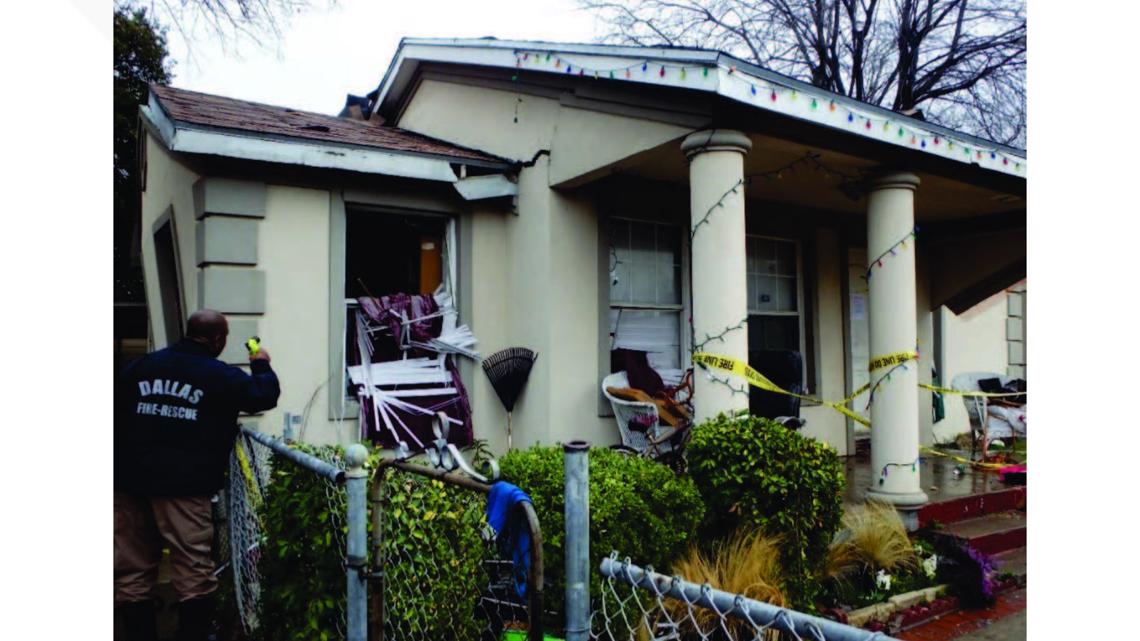
Almost a month later, in the early morning of Feb. 21, 2018, a homeowner woke up and heard a noise coming from the water heater, the report said. As he approached it, a blast threw him back several feet. He suffered burns to his face and knee.
Firefighters arrived, seeing fire coming from the back of the home. An explosion blew off the roof.
A senior service technician dispatched to the scene told investigators he found no indications of a leak on the Atmos side of the gas system, the report said. He wasn’t able to do further testing because of muddy conditions. He also said he couldn’t check the customer’s line because fire crews were still in the home and it posed a safety hazard.
He concluded that the fire was likely gas-related and “probably came from inside the house,” the NTSB report said.
The next day, at 10:21 a.m. a few houses down, a homeowner was cooking. He saw “flames circling around the pot,” according to Dallas Fire-Rescue records. When he went to turn it off, “all he remembers is being thrown backwards” by the force of the explosion.
A neighbor told fire investigators that she had been having problems with her gas service. She said she’d contacted Atmos a few days earlier to ask if there were any issues in the neighborhood.
“She stated that the representative told her there were no problems with the gas service in her neighborhood and that everything was normal,” according to the Dallas Fire-Rescue report.

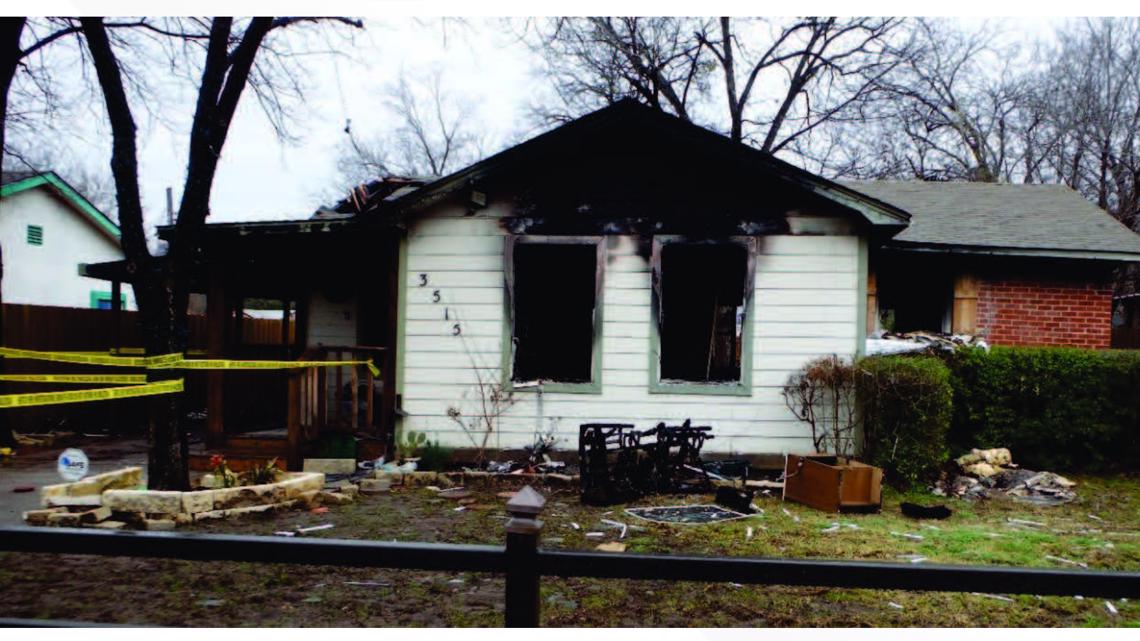
Service technician Juan Cruz told investigators that when he arrived on scene, he learned of the earlier explosion three houses down.
“I knew then that was something my supervisor needed to be notified off," Cruz testified during a deposition. "I called my supervisor and he sent me help."
It was Cruz’s call to his supervisor that would trigger a significant Atmos presence, records show. Atmos workers began looking for leaks and punching small diameter holes – known as bar holes -- into the ground to try to find them.
“I believe we went above and beyond to make that area safe,” Cruz testified.
'That was a lot of leaks'
On the afternoon of Feb. 22, 2018, survey specialist Gavin Hornsby began searching for leaks using a remote methane leak detector in the alley. He told investigators that he discovered “one solid indication all the way down.”
According to the July NTSB report, Hornsby reported the readings to his supervisors and one of them told that "other technicians had already performed bar hole testing in the area and did not detect gas."
“He told me I didn’t need to investigate anything down that alley,” Hornsby testified in a deposition.
That supervisor had interpreted the readings as “false positives,” the NTSB report said.
In his deposition, operations supervisor Juan Gomez said Hornsby mentioned the equipment was going off in “every direction he pointed it in, but no really good indications that it was methane back in that alley.”
But he also said in his deposition that he had "very little knowledge" of the effectiveness of the remote methane leak detector.
“We didn’t have any indications that we had any trouble in that alley,” Gomez testified.

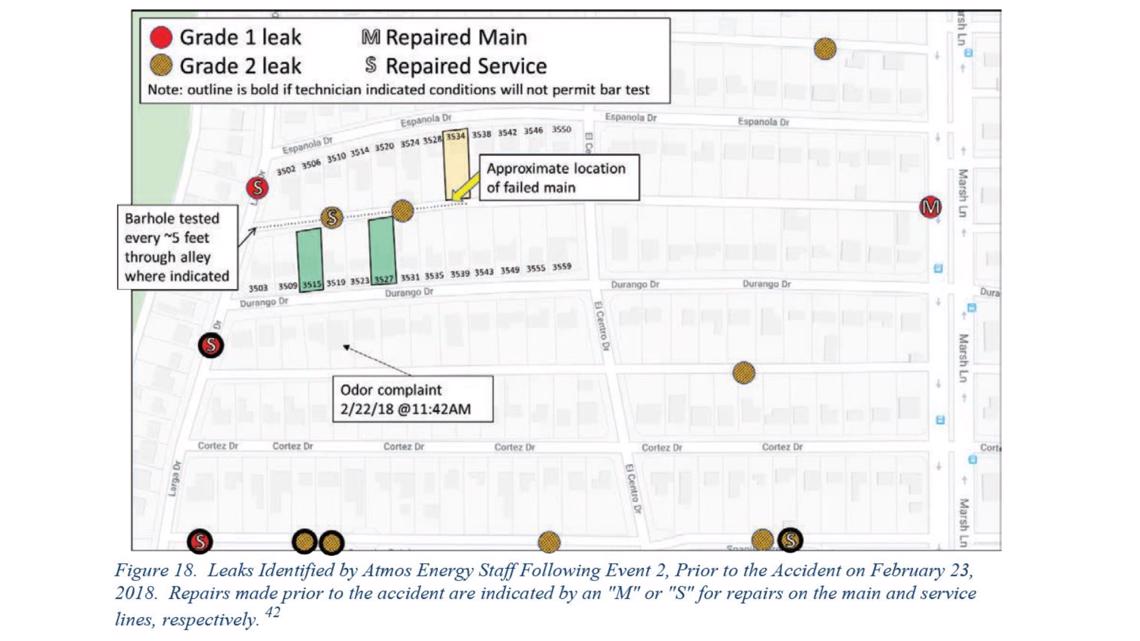
Meanwhile, Atmos crews were finding more and more leaks in the neighborhood throughout the day, into the night and in the early morning hours of Feb. 23. Workers were hampered in their efforts to find and repair leaks by the extreme weather conditions and wet ground conditions.
At one point, a neighbor approached an Atmos worker, telling him she’d seen bubbles in her front yard.
“I waved my detector over where the water was at and it was picking up gas,” Cruz said in a deposition.
It was deemed a hazardous leak, meaning it needed to be fixed immediately.
At another point, Atmos workers found a hazardous leak migrating toward a house, according to NTSB records. Workers broke a locked gate and evacuated a woman from a garage apartment.
From the afternoon of Feb. 22, to the morning of Feb. 23, Atmos crews identified four hazardous and nine non-hazardous leaks in an eight-block area, NTSB records show.
“There was nothing routine about that night,” Atmos survey specialist Joel Reyes said in the report. “We had 10 leaks. That was a lot of leaks. I’ve never investigated that many leaks in one day.”
However, he testified that "he had not been concerned about the integrity of the main line," the NTSB report said.
Operations supervisor Michael Rose, in his deposition, was asked if it was “unusual” to be “hopping from location to location finding” leaks?
He replied, “No, sir. We’ve had this before.”

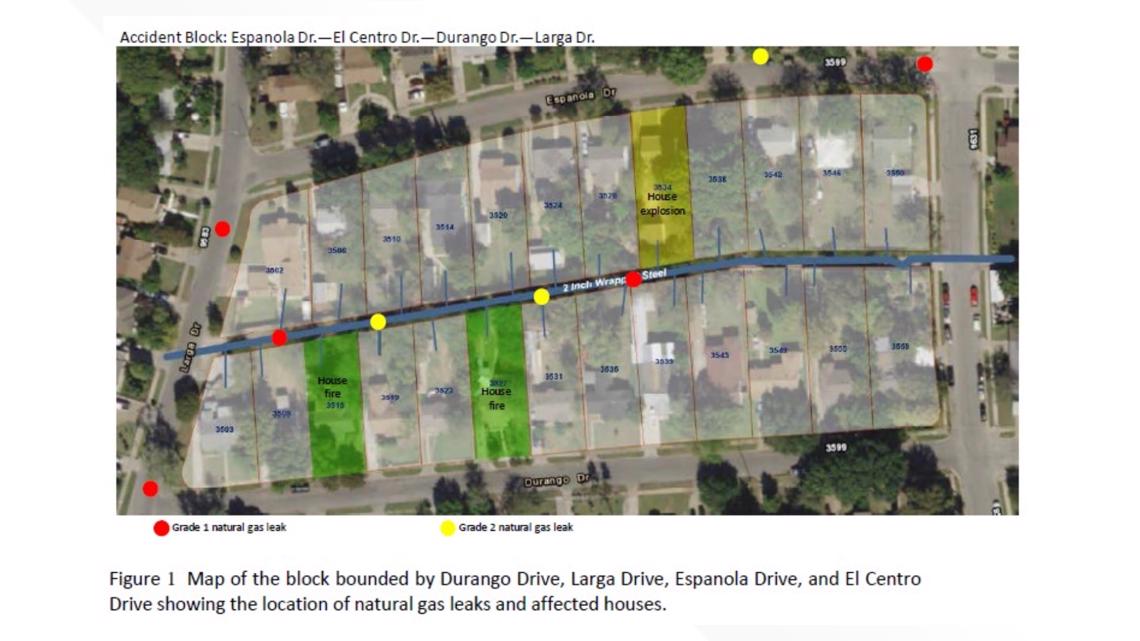
At that point, Atmos officials viewed the two house explosions as being unrelated to the company’s system, according to the depositions.
"[The first two house explosions] seemed at that time sort of independent" of each other, Atmos operations supervisor Benny Rosenberg testified.
Of the two house explosions, Kyle Slaughter, Atmos director of operations, testified in his deposition, "It was a typical fire call we get. We get many of those in the Dallas area, I would say almost daily."
As a precaution, he testified he ordered leak surveys in the neighborhood.
In response to a question during his deposition about why he did not order the gas to be shut off, Slaughter answered, "[We] had the leaks identified and had crews on them. .. I felt like we had everything under control."
Michelita Rogers
Just before sunup on Feb. 23, Michellita Rogers was in her bedroom making videos preparing for a cheerleading competition.
“Good morning,” she says in a 32-second video she's recorded on her phone. “It’s 6:02 a.m. Friday. … I’m going to get ready. I'm going to start with hair, turn on my lamp because I don't want to turn on all of the lights...”


Her mother, stepfather, grandmother and brother were also in the house, but still asleep, the family told WFAA.
On the last of three videos, she’s fixing her hair. Three seconds in, there’s a flash, and one split-second frame appears to be a shower of sparks. It is the last image you see before the video fades to black, the video showed.
In that moment, her young life ended.
Michellita took the brunt of the blast, fire records show. Her brother saved the lives of his other family members by them getting them out of the house.

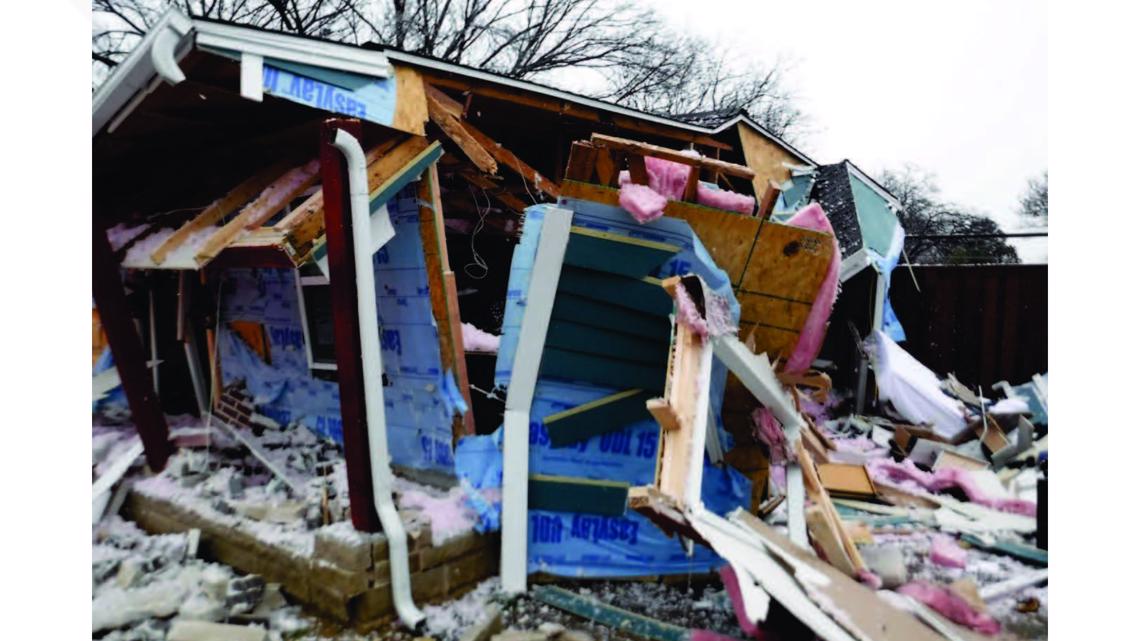
911 calls began pouring in.
“There's a house that exploded in the 3500 block of Espanola,” a caller reported to Dallas 911. “See something wrong with the gas lines here.”
By the time Michellita’s house exploded, Atmos crews had fixed four hazardous leaks and two non-hazardous leaks, according to the NTSB report.
Rose, an Atmos operations supervisor, was a street over on Durango entering leaks into a computer when he heard the blast. He testified that he thought it might be a car wreck. He jumped into his truck and drove around to see the exploded house, its front falling in.
“We started coning the alley and everything and we started to evacuate homes,” Rose testified.
Workers began working to cut off the gas to the back alley separating the exploded houses on Durango and Espanola drives. By that evening, Atmos crews had shut off gas service to a nine-block area, NTSB records show.
“We’d say get a crew out there and take care of that leak and you go back over that area again and there was new leaks,” Jeffrey Knights, Atmos Energy’s Vice president of Technical Services, testified in his deposition. “So it was something that was unexplained. I’ve never seen it in my 25 years of working for the gas company.”


Main installed in 1946
According to the NTSB July report, a two-inch diameter steel main buried in the alley served the three houses that exploded. It had been installed in 1946.
Investigators found that it had been cracked and dented, photographs and records from the records show.
Atmos’ leak data showed “no history of leaks in the 10 years prior to this accident,” the NTSB report said.
The day after Michellita’s house exploded, Atmos announced they had 40 replacing 2.5 miles of pipe. On March 1, Atmos expanded the area, announcing that it would be disconnecting natural gas services and replacing the natural gas lines to about 2,800 homes in Northwest Dallas, the NTSB report said.

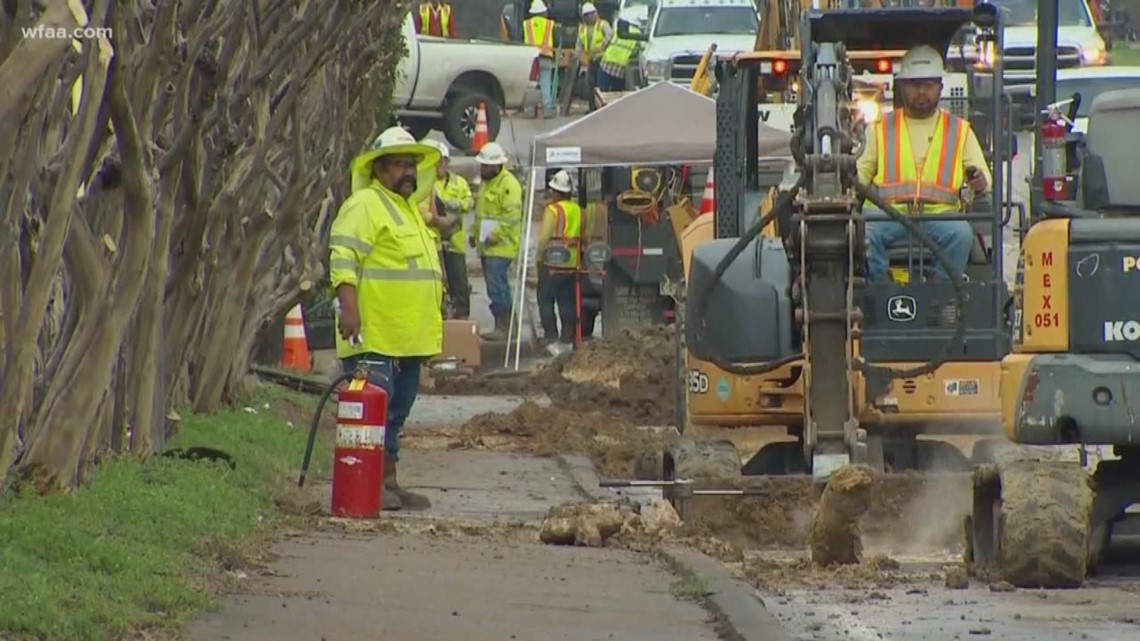
Atmos Energy also decided to bring in a soil expert, Bryant Consulting Inc., or BCI, to attempt to explain what Atmos officials believed caused the extraordinary number of leaks in the Northwest Dallas neighborhood.
The consultant concluded there were two different geological formations underlying that area of Northwest Dallas.
“Each of these formations have different soil properties and swell characteristics,” BCI concluded. “The close proximity of these two formations creates a geological ‘hinge point’ where the land generally to the west of Marsh Lane may move more relative to the land east of Marsh Lane where more uniform and stable soil and moisture conditions are generally encountered.”
BCI theorized that “the recent extended period of rain has likely exacerbated this movement,” and concluded Atmos could not have anticipated or foreseen these conditions.
Months later, video records show that Atmos’ then-president Mike Haefner appeared before the Dallas City Council.
“An extraordinary confluence of events in a limited geographical area damaged our pipeline system in that area, he told the council.
Haefner cited BCI’s report as an explanation.
When a council member questioned why sewer lines, sprinkler systems, sidewalks and other infrastructure didn’t have similar issues, Haefner said he didn’t know the answer.
'Only one geologic formation'
A year later, the Corps of Engineers came to a different set of conclusions.
"BCI’s report asserts there are two different geologic formations, the Eagle Ford and Austin Chalk, underlying the accident site," the Corps report said. "USACE, Fort Worth District disagrees that there are two different geologic formations underlying the accident site. Based on the site-specific borings, drilled as part of the USACE subsurface investigation, there is only one geologic formation, the Eagle Ford Shale, underlying the accident site."
"Furthermore, based on the lab test results, the plasticity characteristics and swell potential of the subsurface materials within the accident block are highly uniform," the report said.
In records obtained by WFAA, Atmos’ vice president of pipeline safety addressed the apparent discrepancy, according to an April 2019 email to an NTSB investigator.
“BCI was not engaged to investigate or draw conclusions regarding the events” related to the three house explosions, John McDill, Atmos’ vice president of pipeline safety, wrote. “At the request of the NTSB, Atmos Energy instructed BCI not to obtain core samples or conduct geological subsurface testing in the alley of the 3500 block of Espanola Drive and Durango Drive."
McDill, in the email, denied the company had ever “publicly connected” BCI’s findings to the three house explosions.

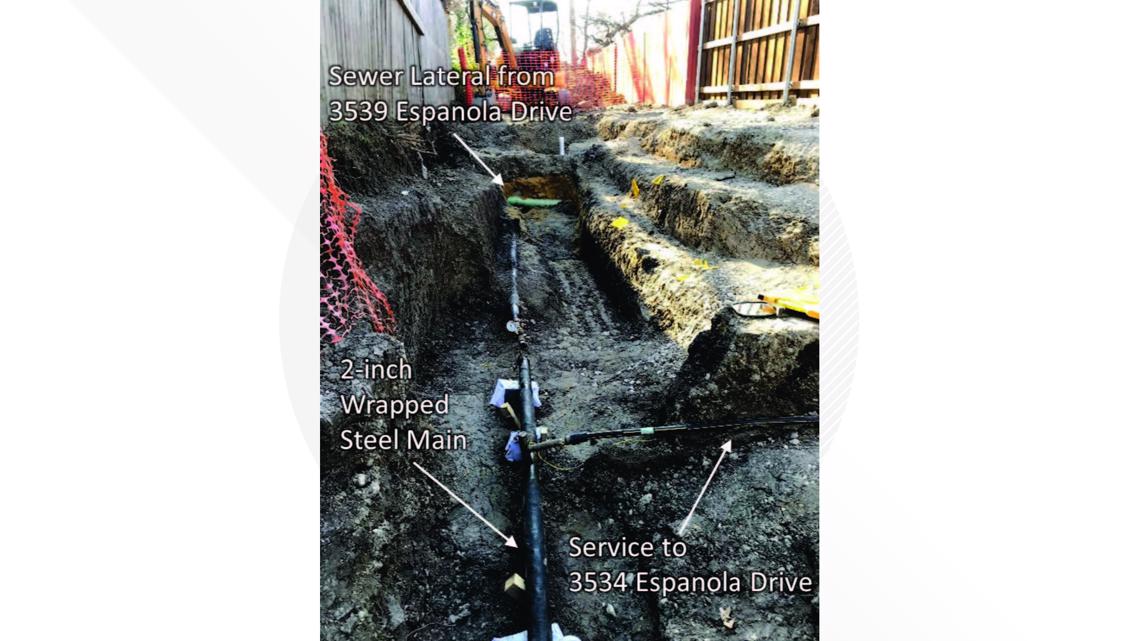
In a statement to WFAA, Atmos said “these documents do not include any findings, recommendations or probable cause, which typically follow later in a final report.”
“We continue to assist the NTSB with the investigation and look forward to its conclusion,” the statement said. “In the meantime, as a party to the investigation, we will abide by our obligation not to make public comments.”
Replacing 5,000 miles of pipe
The company also said in a statement the company plans to spend up to $11 billion to replace more than 5,000 miles of pipe over the next five years.
That includes about 300 miles of aging cast iron pipe that remain in Dallas County. The company said it will meet the December 2021 deadline to replace the cast iron pipe imposed by state lawmakers.
According to the NTSB July report, Atmos officials have now incorporated a new “geological risk factor” into their modeling as a result of BCI’s findings.
They have also updated their leak survey and leak investigations to include mandatory 911 notification and the establishment of a safety perimeter when hazardous conditions are discovered.
The company also told the NTSB it created a “dedicated work group” to “support and monitor leak survey activity.”
But beyond all the depositions and investigators reports is a little girl who never made it to that cheerleading competition.

